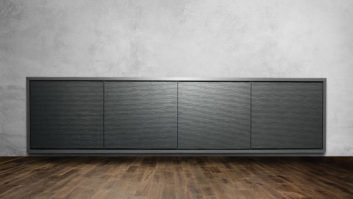HD Flow Wireless Multimedia Kit
HDMI’s proliferation seemed to happen virtually overnight; one minute everything was component video and then BAM! The entire CE industry switched to HDMI. Then Blu-ray arrived, every TV suddenly became 1080p, and the “analog sunset” darkened HD component video outputs meaning that “no HDMI” meant living in a sad and blurry, low-res 20th century world.

Peerless Mount’s new HD Flow is a wireless multimedia kit designed to transmit 1080p HDMI signals up to 131 feet.
Undoubtedly, many electronic systems contractors face numerous existing component video prewired installs, and if a client wants to upgrade to a new flat panel or projector and revel in full 1080p glory, what’s an installer to do? I personally had two clients that would have bailed on $15,000 projector upgrades if an HDMI retrofit wasn’t possible. But sometimes a cable retro isn’t possible, and even if it is, with the cost of a lengthy cable and the labor involved, it might end up killing the deal.
At the Ingram-Micro Spring Expo I discovered Peerless Mount’s new HD Flow, a wireless multimedia kit designed to transmit 1080p HDMI signals up to 131 feet. My previous experience with wireless (or powerline) HDMI systems had been spotty, and I told the Peerless reps at the event that I’d love to test their system. “But be warned,” I cautioned, “if you send it to me, I AM going to try and break it. So only send it if you’re sure that it’s going to work.”
Challenge accepted!
The basic HD Flow system, the HDS100 ($419.99 MSRP), consists of a single transmitter and receiver. Up to three additional receivers (HDS100R, $190 each) can be added; however, running multiple units limits transmission resolution to 720p. The transmitter has two HDMI inputs along with component/VGA and composite and analog audio inputs. The receiver has matching HDMI, component, composite, and analog audio outputs. There is no cross-conversion, such as component outputs via component, etc. The transmitter has an IR output allowing users to control remotely located sources, but this proved inconsistent for me.
I installed the transmitter in the furthest room of my 2,000-square-foot home, meaning that signals traveled through three walls to reach my TV. I also installed it in various locations in my custom showroom. Installation consisted of connecting an HDMI cable from a Kaleidescape M300 player and then powering the transmitter. The receiver connected to my processor via HDMI and the units found each other shortly after powering on the receiver. No other configuration was required.
My first impression was that 1080p HD video looked really good. I watched several upconverted DVD and Blu-ray movies and was hard pressed to notice any image differences between the wireless and hardwired images. (Using the Kaleidescape allowed me to flip very quickly between two separate yet bit-identical feeds.) I was impressed– and relieved–that there was never any stuttering or dropouts. Upon closer scrutiny, I noticed that HD Flow introduced some line twitter and edge artifacts not present on the direct wire. For instance, on the opening pan into the glass building shot of The Dark Knight, some of the fine detail in the grating and building edges weren’t as stable.
To really examine the video, I loaded the Spears & Munsil HD Benchmark Blu-ray. On test patterns, it was apparent that the HD Flow clipped the Red, Green, and Blue color channels and the extremes of both white and black levels. Also, some of the horizontal pan tests exhibited some choppiness. While this may sound extreme, remember that people don’t “watch” test patterns, and these often reveal things unnoticed in realworld video. The errors I noticed in the test patterns weren’t bothersome while watching actual program material. I would notice some of the scaling issues, but I am a trained viewer, and after years of viewing, I am sensitive to that.
Sonically, the HD Flow claims to pass twochannel PCM and Dolby and DTS 5.1 bitstreams at 448 Kbps. While the spec says it passes Dolby and DTS, in my experience it did not. I was only able to get two-channel audio from a variety of sources. Fortunately, two-channel PCM is available regardless the format–including when Dolby TrueHD or DTS HD-Master is selected–meaning that when connecting directly to a display, you should be fine.

From an ergonomics standpoint, early on it was obvious that the HD Flow components run hot and are recommended to stand vertically for better airflow. This probably rules out mounting it behind a flat-panel TV.
While I cannot say that the HD Flow delivers an image bit-identical to a direct cable, I can say that I doubt 99 percent of the general public would notice the video issues unless they were specifically pointed out. The audio shortcomings are a potentially bigger problem, and this definitely won’t solve beaming Blu-ray audio to a remote theater. Bottom line: when you can pull a direct cable, do so. When you can’t, the HD Flow offers a solution that might allow you to end up looking like a hero.
800.865.8870
www.hdflow.com
Kudos
Offers a simple, quick and relatively cost effective solution for adding 1080p via HDMI to areas where running a cable is impractical or impossible; wireless transmission is very stable.
Concerns
Lack of high-res audio and 3D support, multicasting drops resolution to 720p, video not bit-perfect to straight cable solution
Product Specs
■ Dedicated 802.11n, 5-GHz network wirelessly transmits HD audio and video signals
■ Supports multiple video formats includes 4801/p, 720p, 1080i/p (24/30/60)
■ Transmits IR commands for remote component control
■ Wireless transmission up to 131-feet; Wired LAN works up to 500-feet
■ Transmitter supports up to four receivers (in 720p multicast mode)
■ Transmits HDMI, component, VGA, or composite video







